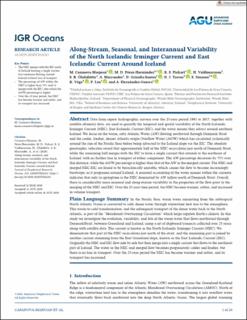Along‐stream, seasonal, and interannual variability of the North Icelandic Irminger Current and East Icelandic Current around Iceland
| dc.contributor.author | Casanova-Masjoan, M | |
| dc.contributor.author | Perez-Hernandez, MD | |
| dc.contributor.author | Pickart, Robert S. | |
| dc.contributor.author | Valdimarsson, Héðinn | |
| dc.contributor.author | Ólafsdóttir, SR | |
| dc.contributor.author | Macrander, Andreas | |
| dc.contributor.author | Grisolía-Santos, D | |
| dc.contributor.author | Torres, Daniel J. | |
| dc.contributor.author | Jónsson, Steingrímur | |
| dc.contributor.author | Våge, Kjetil | |
| dc.contributor.author | Lin, Peigen | |
| dc.contributor.author | Hernández-Guerra, A | |
| dc.date.accessioned | 2021-08-04T10:53:44Z | |
| dc.date.available | 2021-08-04T10:53:44Z | |
| dc.date.created | 2020-11-14T23:54:53Z | |
| dc.date.issued | 2020 | |
| dc.identifier.issn | 2169-9275 | |
| dc.identifier.uri | https://hdl.handle.net/11250/2766171 | |
| dc.description.abstract | Data from repeat hydrographic surveys over the 25-year period 1993 to 2017, together with satellite altimetry data, are used to quantify the temporal and spatial variability of the North Icelandic Irminger Current (NIIC), East Icelandic Current (EIC), and the water masses they advect around northern Iceland. We focus on the warm, salty Atlantic Water (AW) flowing northward through Denmark Strait and the cooler, fresher, denser Atlantic-origin Overflow Water (AtOW) which has circulated cyclonically around the rim of the Nordic Seas before being advected to the Iceland slope via the EIC. The absolute geostrophic velocities reveal that approximately half of the NIIC recirculates just north of Denmark Strait, while the remaining half merges with the EIC to form a single current that extends to the northeast of Iceland, with no further loss in transport of either component. The AW percentage decreases by 75% over this distance, while the AtOW percentage is higher than that of the AW in the merged current. The NIIC and merged NIIC-EIC are found to be baroclinically unstable, which causes the flow to become increasingly barotropic as it progresses around Iceland. A seasonal accounting of the water masses within the currents indicates that only in springtime is the NIIC dominated by AW inflow north of Denmark Strait. Overall, there is considerably more seasonal and along-stream variability in the properties of the flow prior to the merging of the NIIC and EIC. Over the 25-year time period, the NIIC became warmer, saltier, and increased in volume transport. | en_US |
| dc.language.iso | eng | en_US |
| dc.publisher | AGU | en_US |
| dc.title | Along‐stream, seasonal, and interannual variability of the North Icelandic Irminger Current and East Icelandic Current around Iceland | en_US |
| dc.type | Journal article | en_US |
| dc.type | Peer reviewed | en_US |
| dc.description.version | publishedVersion | en_US |
| dc.rights.holder | Copyright 2020. American Geophysical Union. All Rights Reserved. | en_US |
| dc.source.articlenumber | e2020JC016283 | en_US |
| cristin.ispublished | true | |
| cristin.fulltext | original | |
| cristin.qualitycode | 2 | |
| dc.identifier.doi | 10.1029/2020JC016283 | |
| dc.identifier.cristin | 1847995 | |
| dc.source.journal | Journal of Geophysical Research (JGR): Oceans | en_US |
| dc.relation.project | Trond Mohn stiftelse: BFS2016REK01 | en_US |
| dc.subject.nsi | VDP::Oseanografi: 452 | en_US |
| dc.subject.nsi | VDP::Oceanography: 452 | en_US |
| dc.identifier.citation | Journal of Geophysical Research (JGR): Oceans. 125(9), e2020JC016283 | en_US |
| dc.source.volume | 125 | en_US |
| dc.source.issue | 9 | en_US |
Files in this item
This item appears in the following Collection(s)
-
Geophysical Institute [1186]
-
Registrations from Cristin [9482]
